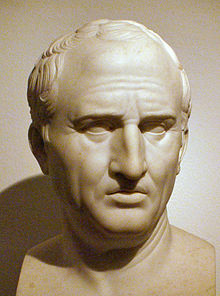
Back قصر الذاكرة Arabic Mètode dels loci Catalan Paměťový palác Czech Dull loci Welsh Hukommelseskunst Danish Loci-Methode German Método de loci Spanish Asukoha meetod Estonian شیوه لوکی Persian Paikkamenetelmä Finnish

| Part of a series on |
| Rhetoric |
|---|
 |
The method of loci is a strategy for memory enhancement, which uses visualizations of familiar spatial environments in order to enhance the recall of information. The method of loci is also known as the memory journey, memory palace, journey method, memory spaces, or mind palace technique. This method is a mnemonic device adopted in ancient Roman and Greek rhetorical treatises (in the anonymous Rhetorica ad Herennium, Cicero's De Oratore, and Quintilian's Institutio Oratoria). Many memory contest champions report using this technique to recall faces, digits, and lists of words.
It is the term most often found in specialised works on psychology, neurobiology, and memory, though it was used in the same general way at least as early as the first half of the nineteenth century in works on rhetoric, logic, and philosophy.[1] John O'Keefe and Lynn Nadel refer to:
... "the method of loci", an imaginal technique known to the ancient Greeks and Romans and described by Yates (1966) in her book The Art of Memory as well as by Luria (1969). In this technique the subject memorizes the layout of some building, or the arrangement of shops on a street, or any geographical entity which is composed of a number of discrete loci. When desiring to remember a set of items the subject 'walks' through these loci in their imagination and commits an item to each one by forming an image between the item and any feature of that locus. Retrieval of items is achieved by 'walking' through the loci, allowing the latter to activate the desired items. The efficacy of this technique has been well established (Ross and Lawrence 1968, Crovitz 1969, 1971, Briggs, Hawkins and Crovitz 1970, Lea 1975), as is the minimal interference seen with its use.[2]
The items to be remembered in this mnemonic system are mentally associated with specific physical locations.[3] The method relies on memorized spatial relationships to establish order and recollect memorial content. It is also known as the "Journey Method", used for storing lists of related items, or the "Roman Room" technique, which is most effective for storing unrelated information.[citation needed]
- ^ e.g. in a discussion of "topical memory" (yet another designator) Jamieson mentions that "memorial lines, or verses, are more useful than the method of loci." Alexander Jamieson, A Grammar of Logic and Intellectual Philosophy, A. H. Maltby, 1835, p112
- ^ O'Keefe, John; Nadel, Lynn (December 7, 1978). The Hippocampus as a Cognitive Map' (PDF). Oxford: Oxford University Press. ISBN 978-0198572060.
- ^ Carlson, Neil R. (2010). Psychology the science of behaviour. Pearson Canada Inc. pp. 245. ISBN 9780205645244.